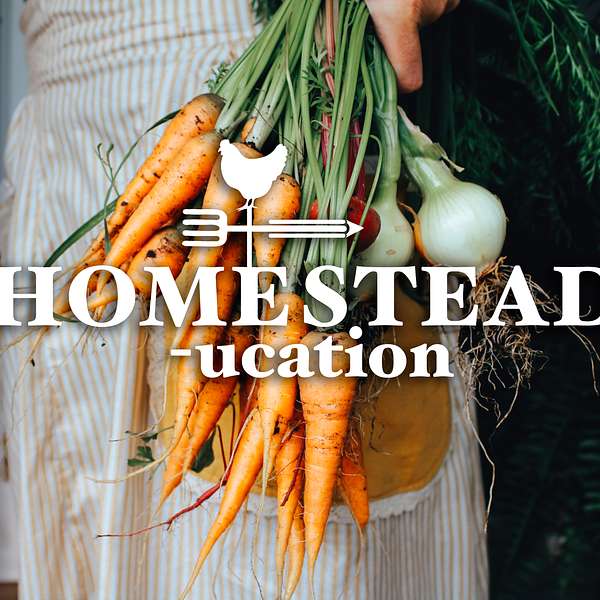
HOMESTEADucation
A podcast for those who are looking to slow down, return to their roots and feel more self-sufficient. Join Mandi Pickering of Wild Oak Farms, and Angela Ferraro-Fanning of Axe & Root Homestead in their new podcast HOMESTEADucation, created by homesteaders for homesteaders. This podcast will explore different facets of homesteading in detail including vegetable gardening, fruit orchard care, animal husbandry, and more. Follow us on Instagram: Angela @axeandroothomestead and Mandi @wildoakfarms
HOMESTEADucation
How Much Food to Grow Per Person
How Much Food to Grow Per Person
Different for every grower. Plant quantities are based on tastes, cooking frequency, root cellar availability, preservation skillset, dietary requirements, etc.
Look at your grocery bill
What are you buying frequently from the store? How much are you buying?
Is there something you can grow instead of buying from the produce section?
Is there something you can grow to preserve (tomato sauce)?
- Do you want to grow for fresh eating? And preservation? And storage? What about to sell? If so, quantities change.
Example: Angela grows 30-35 tomato plants for fresh eating and canning into sauce for a year. This quantity of plants is based on personal experience.
Example: Mandi grows a shitload of lettuce every season. She has enough for her family to eat daily and also to set out at her Farmacy farm stand.
- Set realistic goals for your garden space. Here’s recommended garden size for one year of food:
Vegetarians: 4400 square feet of growing space per person
Omnivores: 200 square feet of growing space per person
-also found-
4400 square feet of growing space per person for a whole year
200 square feet of growing space per person just for the season
- Recommended quantities as a general guide for fresh eating and minimal preservation habits, per person
Asparagus (1 plant/ft. of row), 5-10 plants per person
Bush beans (2 plants/ft. of row), 12-15 plants
Beets (Thin to 3 plants/ft. of row), 15-30 plants
Cucumber (1 plant/2 ft. of row), 1 vine, 2 bushes
Carrots (Thin to 12 plants/ft. of row), 48 plants
Corn (1 plant/ft. of row), 10-15 plants (plant in blocks for best pollination)
Eggplant (1 plant/2 ft. of row), 2-3 plants
Kale (10/10 ft. of row), 2-7 plants
Leaf lettuce (Thin to 3 plants/ft. of row), 24 plants
Melon (1 plant/6 ft. of row), 1-2 plants
Onion (4 sets/ft. of row), 12-20 sets
Peas (6 plants/ft. of row), 15-20 plants
Pepper (1 plant/ft. of row), 3-5 plants
Potato (1 plant/ft. of row), 10 plants
Radish (thin to 12 plants/ft. of row), 10-15 plants
Spinach (Thin to 6 plants/ft. of row), 30-60 plants
Squash (1 plant/6 ft. of row), 1-2 plants
Tomato (1 plant/2 ft. of row), 2-4 plants
Zucchini (1 plant/3 ft. of row), 1-2 plants
- Achieve higher yields in the garden to sustain family members by growing in succession. This saves on space.
- For example, sow radish seeds every two weeks in a new spot in the garden. You will have continuous harvests for fresh eating and preservation rather than growing and harvesting all at once.
- Plant extra to ensure a “bumper crop.” This acts as insurance from crop loss due to pests, disease and unforeseen events.
- There’s only so much room in the designated garden. Amended raised bed soil and in-ground garden space is premium real estate. To save that growing space for more tender vegetables and annuals, look to other “places” to grow your own food outside the garden beds.
- Orchard plants
- Start a berry patch
- Grow pumpkins outside the garden
- Asparagus, potatoes, garlic, and onions are all deer tolerant and don’t need to be grown within a fence (though they do offer companion planting benefits)
- Angela has grown greens in window boxes off the house
- Resources for further reading:
https://www.almanac.com/video/how-many-garden-to-feed-family<